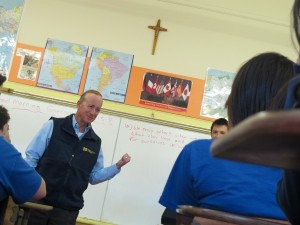Could Indiana's School Vouchers Save The State Money?

Kyle Stokes / StateImpact Indiana
Gov. Mitch Daniels speaks to a group of students at Our Lady of Hungary Catholic school. He visited several classrooms during an hour-long visit.
When Gov. Mitch Daniels asked a class of 20 seventh graders at Our Lady of Hungary Catholic school how many of the students were in their first year at the school, a half-dozen raised their hands.
Enrollment has spiked 60 percent this year at Our Lady of Hungary because of the Indiana’s new voucher program.
“Is [Our Lady] harder than the school you went to before?” Daniels asked. Yes, one girl replied. “Hard’s good though, right?”
Yes, the students admitted, somewhat begrudgingly. But Daniels says he believes the program isn’t only offering voucher students a more rigorous curriculum — it’s also saving the state money.
“The test scores in this school, with its limited means — far fewer dollars than the public schools have, much less money per child — are superior to what they’re getting,” Daniels says.
How much is the state saving? $20 million, estimates voucher program supporter Robert Enlow, who runs the Indianapolis-based Friedman Foundation for Educational Choice.
—Indiana Gov. Mitch Daniels during a visit to a school accepting vouchers
“The way the voucher program was designed, there was no way it could cost the state money,” Enlow says.
A family can only receive as much as $4,500 to cover the cost of a student’s tuition. The state funds most public schools at a higher rate per student — South Bend, for example, receives more than $6,000 per student in state funding.
Indiana Department of Education officials have yet to come out with their own estimate of the voucher program’s cost. Daniels did not cite specific figures during his visit.
The governor picked the small South Bend parochial school to be his first stop on a tour of voucher schools. Our Lady of Hungary now has the largest concentration of voucher students in the South Bend area.
Meanwhile, South Bend’s public schools have lost 373 students to the voucher program — only Indianapolis and Fort Wayne lost more students — costing the district $2.3 million.
John Ritzler, director of research and evaluation for the South Bend public schools, says he agrees that a voucher system is cheaper, but fears it could hurt students who need the most help.
“Any capitalistic or market system will create stratification,” Ritzler says. “You’ll have a market for high-end products and a market for low-end products. That’s the exact opposite of what public education in our country was set up to do. Public education was set up to provide quality, free, and appropriate education for all students.”
Ritzler says private schools won’t take any student — such as those with special needs or troubled academic or personal pasts — like public schools will.
Daniels says there are non-traditional public school options, such as charter schools, which exist solely to serve students with special needs.
When it was passed, Indiana’s program was billed as the most inclusive voucher program in the country. Unlike other programs across the country, Indiana’s program is not restricted to one city (like Milwaukee or Cleveland) and has slightly less stringent income limits than in other voucher schemes.

Kyle Stokes / StateImpact Indiana
From our original report on Our Lady of Hungary in September: Teacher Heather Snavely asks a student to stay seated while playing math games in her classroom.
But the program is currently far from the nation’s biggest. 3,919 students are now enrolled in Indiana’s voucher program — compare that with roughly 20,000 enrolled in Milwaukee’s program.
The state had made 7,500 scholarships available, but families had only eight weeks before the school year began to apply for the vouchers. Though the state will make 15,000 vouchers available next school year, Daniels says he isn’t sure all of those vouchers will get used up.
“I’m not sure that it will ever be a huge program in this state, it may always just be a percent or two of our kids. That’d be fine, because it means the other parents are confident that their child is getting a great public education in the other public school or charter school that they’re in,” Daniels says.

